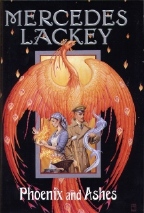Phoenix and Ashes
Mercedes Lackey
DAW Books/Penguin Putnam
US Hardcover First Edition
ISBN 0-7564-0161-5
Publication Date: October 7, 2004
Pages; Price: 405; $24.95
Date Reviewed: 18-10-04
Reviewed by: Katie Dean © 2004

REFERENCES
COLUMNS
|
|
|
Phoenix and AshesMercedes LackeyDAW Books/Penguin PutnamUS Hardcover First EditionISBN 0-7564-0161-5Publication Date: October 7, 2004Pages; Price: 405; $24.95Date Reviewed: 18-10-04Reviewed by: Katie Dean © 2004 |
|
|
REFERENCES |
COLUMNS |
'Phoenix and Ashes' is essentially the story of Cinderella. Retold against the background of World War I, Lackey adds a strong dose of magic as a means to spin this simple fairytale into a four hundred-page novel. Mercedes Lackey is not the first author to have thought of retelling a classic fairytale, but the elements needed to turn this story into a compelling novel for adults are sadly lacking. The setting is inadequately drawn and the novel's language lacks richness. The result is a book that is not without entertainment value, but one that falls far short of the standards set by some contemporary masters of the fantasy genre.
In choosing to set the story of Cinderella in the time of the First World War, Lackey is able to twist history to her advantage in some respects. The English upper and middle classes still employed servants and balls were an accepted form of social gathering for the wealthy. Both of these facts sit neatly with the Cinderella fairytale as we know it. The handsome Prince in this particular version is a wounded pilot and Lackey here taps into the classic 'pilot as hero' stereotype. All this means that she has to do very little to change the familiar story. Unfortunately, the setting is poorly drawn and becomes a gratuitous appendage rather than an integral part of the action. Lackey is constantly at pains to tell the reader about the horror and terrible waste of this darker chapter in European history. Yet she conveys no feeling in her descriptions and it is difficult to see how they really matter to the story. The novel is filled with details that amount to no more than name-dropping. Disconnected mentions of Land Girls, Zeppelins, the trenches and Lawrence of Arabia are all intended to call up images of World War I, yet true accuracy and detail are lacking. Land Girls and dashing pilots are in fact more traditionally associated with World War II in the minds of the general public.
In her portrayal of English society in the late 1910s, Lackey creates no feeling of authenticity. She is quick to allude to social snobbery and the changes that war was beginning to force upon society, but once again real feeling and detail are absent. Lackey's task is not aided by her linguistic style. She throws in the odd word or phrase meant to be indicative of the stereotypical English aristocracy, but her language is that of twenty-first-century America. 'Gotten' is not a word that is current in the English language either now or at the beginning of the last century.
The plot of 'Phoenix and Ashes' is entertaining and moves along at a good pace. Lackey is guaranteed success with such a popular fairytale that has already stood the test of time. She takes the magic integral to the Cinderella story and expands it into a well-constructed system of elemental magic. She is clearly more at home in her descriptions of magic than those of English society. This aspect of the novel is far more imaginative and interesting. So too are the characters she portrays. They are well drawn, building upon the stereotypes of good and evil with which Cinderella is traditionally associated. The wicked stepmother and ugly sisters become society bitches, whilst Eleanor (Cinderella) and Reggie (the Prince) are essentially kind and good. The cast is rather two-dimensional, but that is all that this story requires.
Overall this remains an entertaining read, well suited to a young adult market, although some not-so-young adults may also find it a pleasing alternative to everyday life. As a piece of good quality literature, it has little to recommend it.